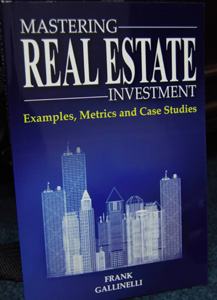Editorial
Front Page - Friday, July 24, 2009
Real Data founder educates investors through books, software
Samara Litvack

As the founder and president of Real Data, Inc., Frank Gallinelli knows a thing or two about real estate research and analysis tools. As a commercial Realtor and investor, he found himself particularly frustrated with a difficult commercial property he was planning to acquire.
“I got fascinated by a new novelty at that point, which was the personal computer,” he says. “So I developed some models for analyzing that particular property and, from there, a software company was born in 1981.”
Real Data, Inc., has been his “day job,” he says, for the better part of the past 30 years. With the success of his company has come a fair share of other duties, one of which has been a lot of writing.
“We were early adopters of the Web and had a Web site in ’96,” he says. “I wrote a lot of articles for that. I think it was in 2003, I got a phone call one day from McGraw-Hill, who had seen some stuff I had written and asked me if I would write a book on real estate investing.”
That book was titled “What Every Real Estate Investor Needs to Know about Cash Flow,” and has been among the top 20 selling real estate books on Amazon since its release.
Next, Gallinelli wrote a book for novice investors and homebuyers titled, “Insider Secrets to Financing your Real Estate Investments.” And last fall, his “Mastering Real Estate Investment” was released.
“That was one that I decided I would self-publish, since I already had fairly significant presence on Amazon and elsewhere,” he says. “That was intended as a sequel, if you will, to the ‘Cash Flow’ book.”
In his first book, Gallinelli explained the basics of investment property analysis and introduced readers to what he considers the “37 key metrics every real estate investor needs to understand.” His newest release is divided into two halves – the first revisits those 37 metrics with more examples, problems and answers, and the second offers a series of case studies in which he puts those metrics into play, showing readers how to actually use them when analyzing properties.
“There’s a parallel here in real life because one of my other undertakings is that I am an adjunct assistant professor at Columbia University,” says Gallinelli. “I teach real estate finance in their Master of Science and Real Estate Development program.”
In his graduate level courses, Gallinelli teaches students the same metrics listed in “Cash Flow,” and applies them to the case studies listed in “Mastering Real Estate Investment,” among others. He teaches students how the metrics are used, how to make decisions, how to recognize red flags, how to recast deals that look bad and what would make a particular deal an accessible investment.
“One thing that I don’t do in any of the books is do the motivational ‘you too can be rich’ kind of hype,” he says. “That may have its place somewhere, but I’m not sure where that place is. It’s got nothing to do with me.”
Rather, Gallinelli says his books teach prospective investors and homeowners how to get down to the “nitty gritty” of investing, analyze the rate of return, attract partners to help provide equity and understand whether they can afford to finance a property.
With his first book already released in an amended second edition, Gallinelli says he is already scratching his head about a second edition of his most recent.
“The case studies have proved very popular,” he says. “The more feedback I get from my grad students, the more ideas I get for the kinds of cases that might be useful.”
Gallinelli considers his professional mission an educational one. As a country, he says America is largely “in the pickle it’s in today” because of a “pancultural” lack of financial literacy. “People just don’t get it,” he says, “in terms of even the simplest concepts of finance.”
A quick visit to his Web site reveals an article – written only half tongue-in-cheek, he says – about investors who have called his company regarding multimillion-dollar deals, not understanding why their software was giving a zero rate of return on a property that was 100 percent financed.
“They’ll say, ‘Well our software’s broken and won’t give us the rate of return on our investment,’” he says. “And we would try to politely say, ‘What investment?’”
Since before it became fashionable, Gallinelli and his company have been on a mission to make their contribution to the country’s level of financial literacy. His books are the most conspicuous example of this, but his teachings, partnered with the way his company deals with its software and customers, makes it apparent.
For more information on Gallinelli’s books or company, look for him on www.amazon.com or visit www.realdata.com.
|
|